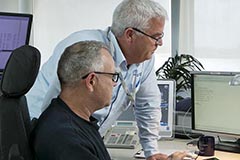The primary objective of the Port Authority of New South Wales (Port Authority) Nominations Committee (Committee) is to assist Port Authority’s Board in fulfilling its corporate governance responsibilities in regard to Board composition.
The Committee is authorised, within the scope of its responsibilities, to:
2.1 Seek information it requires from any Port Authority employee or contractor;
2.2 Take independent legal, financial, remuneration or other professional advice or assistance, at the reasonable expense of the Port Authority. Unless a conflict exists or to do so would be inconsistent with the Committee’s duties, the Committee is to request such information, professional advice or assistance permitted under this clause via the Chairman of the Board.
3.1 The Committee is to consist of two to three permanent members, being Independent Non-executive Directors. An additional temporary member, also being an Independent Non-executive Director, may be appointed where a conflict of interest occurs. Committee Members and the Chairman of the Committee are appointed by the Board.
3.2 The Chairman of the Committee is to be an Independent Non-Executive Director and is to be appointed by the Board.
3.3 Any Director who is not a member of the Committee will have the right to attend any meeting of the Committee.
3.4 The Committee may invite other persons to attend its meetings as required.
4.1 The Committee shall meet on an as required basis. The procedure for meetings of the Committee will be consistent with the procedures for the Board as detailed in the Port Authority’s Memorandum and Articles of Association.
4.2 A quorum shall be two Committee members.
4.3 All decisions of the Committee shall be determined on the basis of a majority vote of members. In the event of a tied vote, the matter will be referred to the Board for decision.
4.4 When the Committee must reach a decision between meeting dates, this decision may be made by circular resolution. In carrying out a vote by circular resolution, the Chairman of the Committee has an obligation to attempt to contact all Committee members. A circular resolution will be passed only when the majority of Committee members vote in the affirmative.
5.1 The Company Secretary or delegate will be responsible for keeping all minutes of all meetings of the Committee. Once the minutes of each meeting have been reviewed by the Chairman of the Committee, they shall be submitted to the Board for information.
5.2 The Chairman of the Committee will inform the Board of the activities of each meeting of the Committee at the Board meeting immediately following the meeting of the Committee.
6.1 Directors of the Port Authority are appointed by the Governor on the recommendation of the Voting Shareholders. The Voting Shareholders will make their recommendation based on a recommendation from the Government selection panel which is chaired by a representative of the Department of Premier and Cabinet.
6.2 The Chairman of the Port Authority will be represented on the selection panel for the purposes of reviewing the composition of the Port Authority Board.
6.3 The Committee is responsible for making recommendations to the Board. The Board will, as appropriate, make recommendations to the selection panel. Specifically the Committee will:
6.3.1 review and advise the Board on the composition of the Board and its Committees;
6.3.2 regularly assess the necessary and desirable skills and experience of directors having regard to the Port Authority’s medium term strategic direction;
6.3.3 ensure the directors have the appropriate mix of competencies to enable the Board to discharge its responsibilities effectively;
6.3.4 identify any skills and experience gaps and develop a Board succession plan to ensure an appropriate mix of skills and experience is maintained and ensure Directors have access to appropriate continuing education as noted in 6.3.8;
6.3.5 identify potential candidates for consideration by the Board, with the necessary skills and experience, to fill these gaps. This will be done using a structured approach to identify a pool of appropriately qualified candidates;
6.3.6 review the performance, skills and experience of any Director or Chair reaching the end of his/her term, noting that the maximum tenure of directors is generally three terms, and make a recommendation regarding re-appointment to the Board. The re-appointment will then be considered by the selection panel representatives from the Department of Premier and Cabinet and Treasury and the Chair of the Port Authority, who will consider the skills and experience of the director against the contemporary needs of the Port Authority Board prior to making a recommendation to the Voting Shareholders;
6.3.7 oversee the directors’ induction program with the assistance of the Company Secretary;
6.3.8 ensure that directors have access to appropriate continuing education to update and enhance their skills and knowledge and to fill any skills gap within the current Board composition;
6.3.9 evaluate the collective performance of the Board, the Chairman of the Board, the individual performance of all the directors and senior management and report the Committee’s findings to the Chairman and/or to the Board as appropriate;
6.3.10 carry out other matters delegated to the Committee by the Board.
7.1 The Committee will:
- Record proceedings of each meeting
- Circulate them to the Board.
7.2 All recommendations of the Committee are to be referred to the Board for approval.
7.3 Ensure the Charter of the Committee is posted on the Port Authority’s website.
8.1 Conflicts of interest
8.1.1 Members of the Committee agree at Committee meetings to comply with the ‘conflict of interest’ requirements of the Port Authority of New South Wales Board Charter, which are:
- Committee members are required to disclose potential conflicts for recording in the Port Authority’s conflicts register. Committee members are required to update this register on an ongoing basis as circumstances change;
- In relation to specific Committee decisions, the Committee complies with Clause 2, Schedule 10 of the Stated Owned Corporations Act 1989. A Committee member cannot take part in discussions or vote on a matter in which that Committee member has a material personal interest; unless the Committee resolves that the interest does not disqualify the Committee member.
8.2 Induction
8.2.1 New members will undergo an induction program to comply with the ‘Induction Program’ requirements of the Port Authority Board Charter, which are:
- Upon appointment, the Company Secretary is responsible for arranging for the new Committee member to undertake an induction program to enable them to gain an understanding of the Port Authority’s business. A range of information is provided, including:
- copies of relevant legislation.
- Code of Conduct
- most recent annual report
- Committee member profiles and contact details
- the Committee Charter
- Statement of Corporate Intent and Corporate Plan
- recent Committee meeting minutes
8.3 Review of Charter
8.3.1 At least once a year the Committee will review this Charter. This review will include consultation with the Board. Any substantive changes to this Charter will be recommended by the Committee and formally approved by the Board.
9.1 The Committee will review and advise the Board on its Diversity* composition.
9.2 Wherever possible and practical the Committee’s aim is to support the Board’s goal to be consistent with the New South Wales state government approach with respect to Diversity* as it relates to Board and Board Committee composition. These benchmarks are currently:
- 50% are female;
- 2.6% are Aboriginal people and Torres Strait Islanders;
- 12% have a disability;
- 7% have a disability and require work-related adjustments; and
- 19% whose first language is not English.
Diversity* includes but is not limited to race, sex, marital status, gender and disability.







